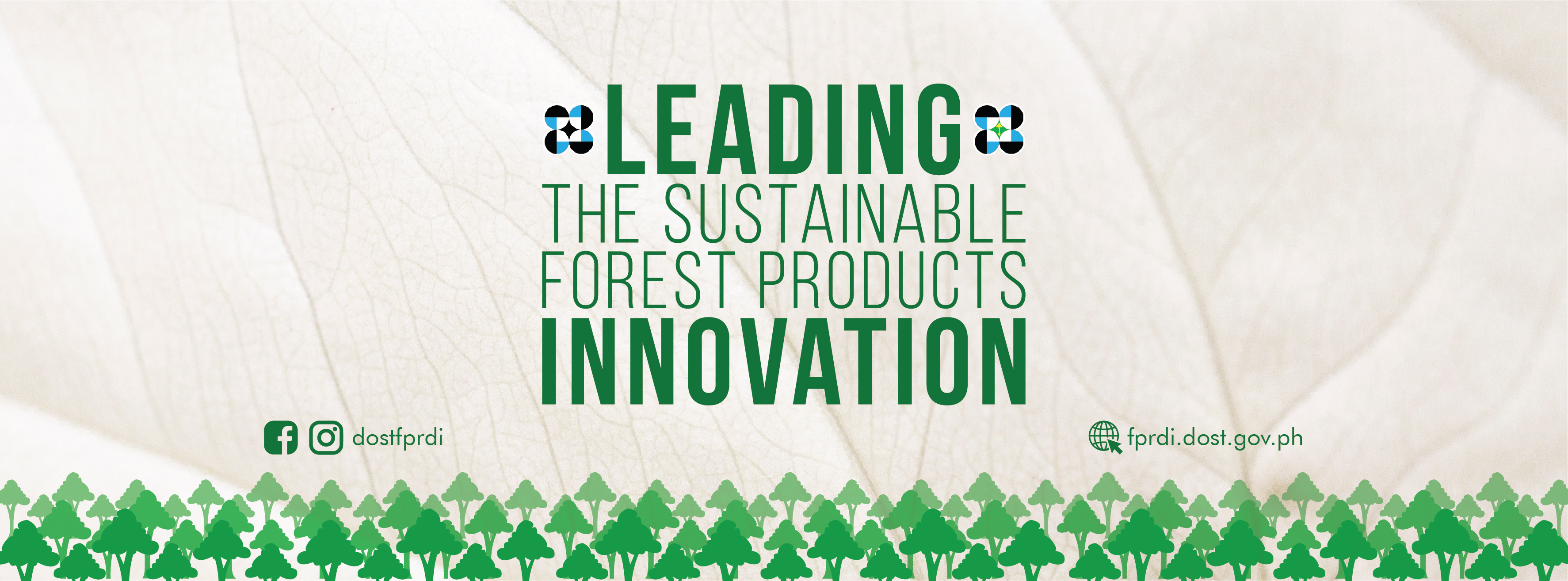Program 4. Natural Rubber Exudates and Wood Utilization
- Details
BACKGROUND
The rubber industry is one of the priority agro-based industries in the Philippines being a priority crop under the Department of Agriculture (DA). In 1997, DA launched the Rubber Development Program (RDP) as a component of Gintong Ani-High Value Commercial Crops Program (GA-HVCC) for the purpose of expanding rubber to 500,000 ha. in 10 years.
The DOST launched the Natural Rubber R & D Agenda during the 1st Philippine Rubber Industry Market Encounter (PRIME) event and was borne out of a series of consultations, mainly with Philippine Rubber Industries Association (PRIA) and rubber processors and farmers in Mindanao. The R & D agenda covered both the upstream through the Industry Strategic Plan (ISP) of the PCAARRD and downstream through the S & T Intervention Program of PCIEERD. Among the issues raised by the industry are poor qualities of natural rubber (NR) and lack of competitive products produced by the country. Other issues identified are lack of researches on product formulation and innovative rubber products. Other problem of farmers is the lack of high value utilization of senescent rubber tree. Generally, rubber wood from senescent tree is used only as fuel.
Natural rubber still holds a significant market share of 30% to 40% over synthetic rubber despite advances in synthetic rubber compounds. NR is used in over 50,000 consumer products and continues to hold the greatest share in tire production. The major advantage of NR over synthetic is its dynamic properties which cannot be substituted in engineering applications. The Association of Natural Rubber Producing Countries (ANRPC) where the Philippines is an active member contributed 93% of the total world production. The ANRPC is composed of 11 countries namely Thailand, Indonesia, India, Vietnam, China, Sri Lanka, Philippines, Cambodia, Papua New Guinea, Malaysia and Singapore. Except for China, India, Sri Lanka, and Papua New Guinea, most of the ANRPC members are mostly ASEAN members. The top three producers are Thailand, Indonesia and Malaysia. According to ANRPC, the NR output of 10.2 million MT in 2010 is projected to increase to 15.4 million MT in 2020. The high rubber demand by different sectors will lead to increasing deficits as disclosed by All India Rubber Industries Association (AIRA). Deficits shall increase for 189,000 MT in 2010 to 840,000 MT in 2020 (Rubber Industry Study 2012). Though the Philippines only contributed 1.1% to the total NR production of ANRPC members, the growing deficit between supply and demand presents are opportunity for the Philippines to expand its production and the industry based on natural rubber as well.
GOAL
To utilize the natural rubber exudates and senescent rubber trees into high value products in increasing the competitiveness of the local rubber industry.
OBJECTIVES
- To enhance the capability of natural rubber industry in processing thru industry partnership, benchmarking and training.
- To develop high value products from natural rubber.
- To utilize senescent rubber tree for furniture making.
- To recommend policy on the use of best latex coagulant.
Program 3. Tree Plantation Species
- Details
LEADER: Dr. Dwight A. Eusebio
BACKGROUND
The efficient utilization of tree plantation species (TPS) has become increasingly more important particularly if these are to be used as substitute to other widely and traditionally used wood species. Wood, aside from being conventionally used as construction and housing material when processed into lumber, has many industrial uses. These are for furniture, pulp and paper, veneer and plywood, composite boards (particleboard, fibreboard, etc.), utility poles (power and telecommunication poles), packaging (pallets, fruit boxes, crates etc), builders’ woodworks (doors, windows, door and window jambs, mouldings, balusters, stairs and railings, shingles and shakes, parquets, etc), fancy woodwork, wooden shoes, pencil slat, cream spoon, chopstick, matchsticks, toothpick and many more. These uses however depend on the properties/characterisitcs (sawmilling, drying, machining, chemical, physical, mechanical, and finishing), natural durability and treatability of wood.
According to a report, the future of the wood-based industries will depend largely on how successful the efforts in developing industrial tree plantations. There is guarded optimism that the investment climate in the forestry sector will improve and translate into more forest plantation development. The furniture industry will continue to be an exporter of high quality products using a mixture of various raw materials such as wood, bamboo and rattan. Forests and forestry in the Philippines in 2020 will see an improvement in the forest cover. This will come mostly in the form of forest plantations. It is projected that an additional 220,000 ha of forest plantations will be established, most as industrial forest plantations. It is projected that by 2020 the Philippines will be producing about 2 million m3 of logs mostly coming from forest plantations. The Philippines will also become a net exporter of lumber, veneer and plywood. It is expected that the country will be exporting 300,000 m3 of lumber, 10,000 m3 of veneer and 50,000 m3 of plywood. Furniture and handicrafts will continue to be foreign exchange earners. (Asia-Pacific Forestry Sector Outlook Study II. Working Paper No. APFSOS II/WP/2009/10, FMB-DENR 2009)
Sawmilling properties of wood refers to sawing method, percent lumber recovery and processing rate on primary conversion of wood while machining is related to wood processing operations such as planing, turning, boring, shaping and mortising. The smoothness and ease with which wood can be worked depends on the wood species. Wood drying (also seasoning lumber or wood seasoning) reduces the moisture content of wood before its use. When the drying is done in a kiln, the product is known as kiln-dried timber or lumber, whereas air drying is the more traditional method. Mechanical properties are related to the strength qualities or characteristics of wood, i.e. static bending (modulus of rupture/elasticity), compression (parallel/perpendicular to grain), hardness (side grain, end grain), shear parallel to grain and toughness while physical properties refer to density, moisture content and shrinkage (longitudinal, tangential and radial) of wood. Chemical properties of wood vary from species to species. The chemical properties being investigated are ash, starch, wood extractives, lignin, cellulose and others. Finishing properties refer to the process of refining or protecting a wooden surface, especially in the production of furniture. It is the final step of the manufacturing process that gives wood surfaces desirable characteristics, including enhanced appearance and increased resistance to moisture and other environmental agents. Finishing can also make wood easier to clean and influence other wood properties.
Natural durability referst to the natural resistance of heartwood to decay, insect or marine borer attack. Regardless of the wood species, sapwood generally has poor resistance to biological attack so the natural durability rating is based only on the heartwood. Tree plantation species like any other wood, are also vurnerable to attack of wood-decaying fungi and wood-destroying insects. Their natural resistance to biological attack varies from one another and the severity of the attack depends on factors such as climate and the condition of wood. Hence, determining the natural durability of tree plantation species is important so that chemical treatment application can be made to protect wood early on from bio-deterioration.
The program comprises R&D projects which generally aims to establish potential utilization of some TPS through properties and quality evaluation. The various project components cover the following: basic properties (physical and mechanical, chemical and anatomical) of some TPS; establishment of preservative treatment schedule; characterization of the active components of TPS to be used for preservatives and efficacy of chemical components/derivatives.
Program 2. Bamboo Processing and Industry Development
- Details
LEADER: Dr. Rico J. Cabangon
BACKGROUND
Bamboo is one of the most economically-important non-timber forest products in the Philippines. Its fast growth and excellent properties makes it an ideal substitute to wood for furniture, handicrafts, construction material, and chemical products. Thus, it is explicable that most of the initiatives undertaken worldwide on bamboo utilization are to exploit its use as substitute to wood. Global market for bamboo in 2006 stands at about 7 billion US dollars and was projected to increase to US$ 17 B from 2015 to 2020.
In the Philippines, where the restriction on the harvesting of wood from natural forests are strictly prohibited by virtue of a moratorium on the cutting and harvesting of timber in the natural and residual forests (Executive Order 23, 2011), bamboo may be tapped as the main material to substitute for the reduced supply of wood. The government’s support on bamboo production and utilization had been increasing recently. Executive Order 879 in 2010 created the Philippine Bamboo Industry Development Council (PBIDC) to provide policy and program directions for the stakeholders of the fast developing bamboo industry. E.O. 879 also directs the use of indigenous material for at least 25% of desk and other furniture requirements of public elementary and secondary schools, and to prioritize its use in furniture, fixtures and other construction requirements of government facilities. E.O. 879 was underpinned by Memorandum Circular No. 30 s. 2012 which directed the full implementation of the Philippine Bamboo Industry Program.
The recently drafted Philippine Bamboo Industry Roadmap identified the following as S&T Interventions: (1) Development of economical methods of drying and preservation; (2) Product development and processing of lesser-used species of bamboo; (3) Development of processing tools, equipment and machineries; (4) Utilization of field and mill residues; (5) Production of rayon from bamboo (cellulose derivatives); (6) Development of more engineered bamboo products. Thus, there is a need to focus on S&T activities to support the development of the Philippine Bamboo Industry.
Investigations on the utilization of bamboo at FPRDI can be broadly classified into basic and applied research and development (R&D). Most of the R&D projects conducted from 1957 to 1990 were mainly basic research and generally dealt with material quality evaluation for end-use classification. Applied R&D on bamboo has been started in mid 1980s to generate processing and utilization technologies for the benefit of bamboo-based industries. Completed R&D projects at FPRDI from 1957 to present (FPRDI 2007 and FPRDI 2008). A total of 93 R&D projects were completed during said period and these cover: preparation of identification manuals (erect and climbing bamboos) and development of data base on basic properties (anatomical structure, physical, chemical and mechanical properties), establishment of processing properties (pulping, veneering, drying, preservation, lamination, bleaching and dyeing, finishing, etc.), product development (pulp and paper, resin-bonded bamboo mat board, cement-bonded board, corrugated bamboo sheet for roofing, laminated bamboo veneer panel and flooring, wood-bamboo glulam, laminated floor tiles, bamboo charcoal/charcoal briquette and industrial light distillate; transport packaging for fruits/vegetables, etc.). Design and fabrication of equipment (charcoal kiln, manual briquettor, bamboo kiln dryer, HPSD treatment apparatus and bamboo veneer lathe).
Research and development activities shall be conducted at the Forest Products Research and Development Institute and if possible in cooperators of individual projects/activities. On the other hand, technology transfer activities developed by FPRDI shall be conducted in locations where project cooperators were identified.
GOAL
To develop a vibrant bamboo industry based on the identified S&T interventions of the Philippine Bamboo Industry Roadmap.
OBJECTIVES
This program attempts to provide interventions to the above-mentioned goals. It aims to:
- Develop products and processing technologies to maximize the use of every part of the bamboo.
- Design and fabricate cost-effective tools/machinery for efficient bamboo processing.
- Improve the properties of bamboo and bamboo products through the use of emerging/novel technologies.
- Transfer FPRDI-generated technologies on bamboo processing and utilization to the industry and rural communities.










